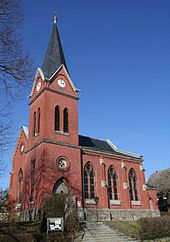Wiesenfeld near Coburg
|
Wiesenfeld near Coburg
municipality Meeder
Coordinates: 50 ° 18 ′ 5 ″ N , 10 ° 54 ′ 30 ″ E
|
|
|---|---|
| Height : | 308 m above sea level NN |
| Residents : | 677 (2004) |
| Incorporation : | May 1, 1978 |
| Postal code : | 96484 |
| Area code : | 09566 |
|
Rectory
|
|
Wiesenfeld bei Coburg (officially: Wiesenfeld b.Coburg) is a district of the Upper Franconian community of Meeder in the district of Coburg .
geography
Wiesenfeld is about seven kilometers northwest of Coburg . The Sulzbach flows through the village. The part of the village on the north-south road to Meeder has the structure of a clustered village , the older part of the village on the original road to Neida that of a street village .
history
In a document dated February 6, 1231, Wiesenfeld was first named as the "Wisentvelt". Ulrich III. von Callenberg sold the place to the Hochstift Würzburg at that time . The community originally belonged to the original parish of Meeder and was raised to a parish in the 16th century.
The Mönchröden monastery owned an estate in Wiesenfeld. From 1353 Wiesenfeld was under the rule of the Wettins and thus since 1485 in the Electorate of Saxony , from which the Duchy of Saxony-Coburg emerged . The rulership of the village was held by the lord of the manor . The last owner Johann Conrad von Scheres-Zieritz died in 1704 and determined in his will that his house and two Wiesenfeld estates should form a foundation to support needy and worthy people of Evangelical-Lutheran creed in old people's homes. The foundation still supports elderly people in need in Coburg today.
In 1508 there were 22 able-bodied men in Wiesenfeld. Ninety years later, in 1618 at the beginning of the Thirty Years War , there were 35. By 1650 the number had fallen to 24. The number of houses decreased from 35 to 26. Of the 23 Selden , 12% were in a "desert" state .
In a referendum on 30 November 1919 67 Wiesenfelder voted citizens against joining the Free State of Coburg the Thuringian State and three for it. On July 1, 1920, the Free State of Coburg was united with the Free State of Bavaria .
In 1961 Herbartsdorf, 1962 Kösfeld and 1964 Sulzdorf were incorporated into Wiesenfeld. The community of Wiesenfeld in 1970 with its districts had 650 inhabitants. On May 1, 1978, Wiesenfeld was forcibly incorporated into Meeder.
In 1987 the village had 544 inhabitants and 130 houses.
Population development
|
church
The Evangelical Lutheran Magdalenenkirche was consecrated in October 1898. The previous building was built in 1724 and burned down on May 27, 1896 along with 41 neighboring buildings. The new red brick church was built in a neo-Gothic style according to plans by the Coburg builder Uden .
traffic
Wiesenfeld is on State Road 2205, which connects Coburg with Bad Rodach . In addition, the district road CO4 crosses the town to Meeder. The Coburg – Bad Rodach railway line has been connected to the railway network since 1892 .
economy
The office furniture manufacturer Leuwico, which was founded in 1923 and has 92 employees (as of 2011), has its headquarters here. Milchwerke Oberfranken West eG has been operating a dairy on the outskirts since 1992 with 331 full-time employees (as of 2012) . In 2013 it produced, among other things, 43,000 tons of cheese.
Personalities
- Erhard Andreas Frommann (1722–1774), Abbot of Berge Monastery and General Superintendent of the Duchy of Magdeburg
Web links
Individual evidence
- ↑ a b Müller's Large German Local Book 2007. Verlag de Gruyter, ISBN 978-3-00-042206-5 .
- ^ Richard Teufel : Architectural and art monuments in the district of Coburg . E. Riemann'sche Hofbuchhandlung, Coburg 1956, p. 166
- ^ A b Klausdieter Ruge: Wiesenfeld . In: Eckhart Kollmer (ed.): Evangelical parishes in the Coburg region . Verlag der Ev.-Luth. Mission Erlangen, Erlangen 1984, ISBN 3-87214-202-X , p. 113
- ^ Rainer Hambrecht: Contributions to the founding, ownership and economic history of the monastery Mönchröden . In: 850 years Mönchröden: The former Benedictine abbey from the first mention in 1149 until the Reformation. Series of publications by the Historical Society of Coburg Volume 13, Coburg 1999, p. 76.
- ^ Egon Resch: Neida 675 years, 1317–1992; Festival days, July 23-26, 1992 . P. 89
- ^ Coburger Zeitung, issue no.280 from December 1, 1919
- ^ Wilhelm Volkert (ed.): Handbook of Bavarian offices, communities and courts 1799–1980 . CH Beck, Munich 1983, ISBN 3-406-09669-7 , p. 441 f .
- ↑ a b Federal Statistical Office (ed.): Historical municipality register for the Federal Republic of Germany. Name, border and key number changes in municipalities, counties and administrative districts from May 27, 1970 to December 31, 1982 . W. Kohlhammer, Stuttgart / Mainz 1983, ISBN 3-17-003263-1 , p. 679 f .
- ↑ Bavarian State Office for Statistics and Data Processing (Ed.): Official local directory for Bavaria, territorial status: May 25, 1987 . Issue 450 of the articles on Bavaria's statistics. Munich November 1991, DNB 94240937X , p. 299 ( digitized version ).
- ^ Egon Resch: Neida 675 years, 1317–1992; Festival days, July 23-26, 1992 . P. 94
- ↑ www.gemeindeververzeichnis.de
- ^ A b Michael Rademacher: German administrative history from the unification of the empire in 1871 to reunification in 1990. City and district of Coburg. (Online material for the dissertation, Osnabrück 2006).
- ↑ Neue Presse Coburg, 4th August 2011 ( page no longer available , search in web archives ) Info: The link was automatically marked as defective. Please check the link according to the instructions and then remove this notice.


